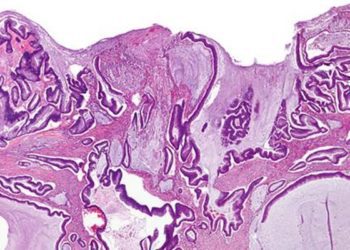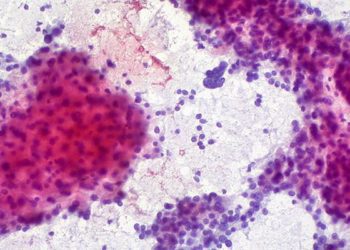New chemotherapy precludes the need for radiotherapy in primary mediastinal B-cell lymphoma
Image: PD
1. DA-EPOCH-R therapy achieved high rates of remission without radiotherapy.
2. Patients receiving DA-EPOCH-R therapy maintained normal cardiac ejection fractions up to 10 years after treatment.
Evidence Rating Level: 2
Study Rundown: Subject to the limitations of a phase-II clinical trial, this study demonstrates that DA-EPOCH-R (dose-adjusted etoposide, doxorubicin, and cyclophosphamide with vincristine, prednisone and rituximab) therapy is safe and effective in treating primary mediastinal B-cell lymphoma in the absence of radiotherapy.
If further trials are successful, DA-EPOCH-R may represent a significant improvement over existing standards as it precludes radiotherapy and its attending side effects, such as secondary malignancies and atherosclerosis.
The sample size of 51 is too small to establish safety profiles. Compared to the de facto standard of R-CHOP chemotherapy, the only addition is etoposide, which itself has a well-established safety profile. Although unexpected drug-drug interactions are always a possibility, this phase-II study suggests that DA-EPOCH-R presents a safe alternative with the promise of high remission rates.
Click to read the study, published online today at NEJM
Relevant Reading: Dose-adjusted EPOCH chemotherapy for untreated large B-cell lymphomas: a pharmacodynamics approach with high efficacy
In-Depth [single group, prospective study]: This prospective study assessed the safety and efficacy of DA-EPOCH-R (dose-adjusted etoposide, doxorubicin, and cyclophosphamide with vincristine, prednisone and rituximab) in treating primary mediastinal B-cell lymphoma. All 51 eligible treatment-naïve patients received DA-EPOCH-R plus filgrastim and were followed for disease progression and toxic effects. There was no control group. Additionally, the study examined retrospectively 16 patients who received DA-EPOCH-R therapy through a study at Stanford.
At a median follow-up of 63 months, the prospective group had event-free survival rates of 93% (95% confidence interval [CI], 81 to 98) with an overall survival of 97% (95% CI, 81 to 99). The retrospective Stanford cohort had 100% (95% CI, 79 to 100) survival and event-free rates over a median follow-up of 37 months.
The study measured ejection fractions in 42 patients to assess cardiac toxicity. All patients had normal ejection fractions up to 10 years post treatment. Additionally, thrombocytopenia (<25,000 platelets per cubic millimeter) occurred during 6% of cycles. Hospitalization for fever and neutropenia occurred during 13% of cycles.
By Xiaozhou Liu and Mitalee Patil
More from this author: Nonemergent perc. coronary intervention safe without on-site cardiac surgery services, Omalizumab relieves symptoms in difficult-to-treat chronic idiopathic urticaria, New device reduces acid exposure in gastroesophageal reflux disease, Neurostimulation beneficial in Parkinson’s disease with early motor complications, Rivaroxaban has no net clinical benefit over enoxaparin for thromboprophylaxis in acutely ill patients, Long term functional outcomes similar with surgery, radiotherapy in prostate cancer patients
© 2013 2minutemedicine.com. All rights reserved. No works may be reproduced without written consent from 2minutemedicine.com. Disclaimer: We present factual information directly from peer reviewed medical journals. No post should be construed as medical advice and is not intended as such by the authors or by 2minutemedicine.com. PLEASE SEE A HEALTHCARE PROVIDER IN YOUR AREA IF YOU SEEK MEDICAL ADVICE OF ANY SORT. Content is produced in accordance with fair use copyrights solely and strictly for the purpose of teaching, news and criticism. No benefit, monetary or otherwise, is realized by any participants or the owner of this domain.


![2 Minute Medicine: Pharma Roundup: Price Hikes, Breakthrough Approvals, Legal Showdowns, Biotech Expansion, and Europe’s Pricing Debate [May 12nd, 2025]](https://www.2minutemedicine.com/wp-content/uploads/2025/05/ChatGPT-Image-May-12-2025-at-10_22_23-AM-350x250.png)




